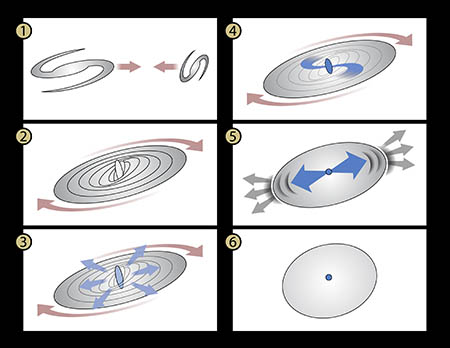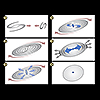GALEX Image

Timeline of the Rise and Fall of NGC 3801
Astronomers believe they have caught the galaxy NGC 3810 at a critical point in its history, just as it is making the transition from a vigorous spiral galaxy to a quiescent elliptical galaxy whose star-forming days are long past. This diagram sketches out the stages leading up to its current observed state and beyond.
- Astronomers think the galaxy NGC 3801 formed around a billion years ago when two young, star-making spiral galaxies, perpendicular to one another, collided.
- The remnant of this merger possessed a central core rotating in a "north-south" direction compared to the "east-west" direction of the surrounding disk.
- The mashing together of gas and dust during the collision and merger unleashed a burst of star formation around 300 million years ago. The shortest-lived, biggest stars blew up in a few million years as supernovae. Winds and shocks from these explosions dissipated some of the cold gas in the galaxy needed to form new stars. Star formation began to decline in NGC 3801 accordingly.
- Around five million years ago, the supermassive black hole at NGC 3801's core started to flare up, sending out jets of fast-moving particles from the surrounding material. Today we see the twin jets bent into an "S" shape from the rotation of the galactic disk. More powerful jets from the black hole appear to have started up in the past one or two million years but have not yet emerged from the galaxy's core.
- In the next few million years, the stronger jets will send out shock waves into the disk of NGC 3801. The remaining gas and dust will be swept up and pushed out of the galaxy.
- In about 10 million years or so, the expanding shock waves will have cleared out the remaining cold gas in NGC 3801 and star formation will cease. NGC 3801 will have transformed into an elliptical "red and dead" galaxy, full of old, red stars.
Credit: NASA/JPL-Caltech
Release Date
April 03, 2012
Download Options

- Full Resolution TIFF [3882x3000, 1.3 MB]
- Full Resolution JPEG [3882x3000, 913 MB]
- Screen Resolution JPEG [450x348, 119 KB]




